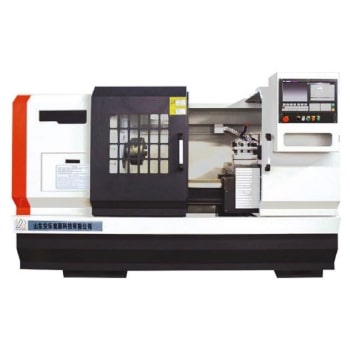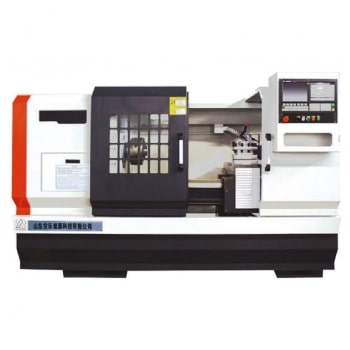Flat Bed CNC Turning Center Metal ALCK6150
Model: ALCK6150 Brand: ALLES CNC Technology Parameter Specifications Unit ALCK615.
Horizontal CNC Lathe Turning Machine for Metal
Model: ALCK6165E Brand: ALLES CNC 1、CNC metal turning lathe machine center both.
What Is a CNC Vertical Lathe?
A CNC vertical lathe is a high-rigidity CNC turning machine with a vertically arranged spindle and horizontally positioned workpiece. Unlike a horizontal lathe, the vertical structure allows the workpiece to be supported by the worktable, making it ideal for machining large-diameter, heavy-duty, and high-precision disc-type, ring-type, and short-shaft components. The spindle is typically mounted in the center of the column, while the tool post moves vertically to perform multiple machining operations such as turning inner and outer diameters, facing, tapering, grooving, and threading. Some models are equipped with dual columns, dual tool posts, or C-axis and live tooling, allowing turn-milling compound machining in a single setup.
Main Application Industries:
1. Energy Equipment Industry: Machining large ring-shaped parts such as wind turbine bearing housings, generator casings, and turbine end covers — requiring high rigidity and concentricity.
2. Aerospace Industry: Used for processing high-precision components such as engine casings, turbine disks, and aircraft structural rings.
3. Heavy Machinery and Metallurgy Equipment: Machining large gear bases, bearing seats, roll ends, and hydraulic cylinder end covers with high cutting forces.
4. Shipbuilding and Marine Engineering: Processing large flanges, propeller connection rings, and rudder bases for ships and offshore equipment.
5. Mold and Construction Machinery Industry: Machining mold bases, rotary support disks, slewing bearings, and bearing rings.
6. General Machinery Manufacturing: Suitable for high-precision end-face and circular machining of large disc- and ring-type parts.
Frequently Asked Questions (FAQ):
1. What’s the difference between a vertical and a horizontal lathe? Structure: The vertical lathe has a vertical spindle, ideal for large and heavy workpieces; the horizontal lathe has a horizontal spindle, better for long-shaft parts. Workpiece support: The vertical lathe uses a worktable for support, providing high load capacity; the horizontal lathe relies on a chuck and tailstock. Processing type: Vertical — suitable for discs and rings; Horizontal — suitable for shafts.
2. What types of parts and materials can be machined? Typical parts: Discs, flanges, bearing seats, valves, hubs, and pump housings. Materials: Carbon steel, alloy steel, stainless steel, cast iron, aluminum alloy, copper, and high-strength alloy steel.
3. How to choose the right vertical lathe model? Consider the following factors: Maximum workpiece diameter and height, workpiece weight and cutting load, machining accuracy and production volume, whether C-axis and live tooling are required for turn-milling, whether automatic loading/unloading system is needed.
4. Daily Maintenance Guidelines: Keep the worktable and guideways clean and free from chips. Regularly lubricate lead screws, guideways, and spindle bearings. Check hydraulic, cooling, and lubrication systems. Periodically calibrate the tool post and spindle concentricity. Apply anti-rust protection during long-term shutdown.
5. Key Advantages of Vertical Lathes: High rigidity structure, suitable for heavy cutting. Stable workpiece support, high rotation accuracy. Ideal for large disc- and ring-type parts. Supports multi-process machining (turning + milling). Compatible with automation and mass production. Easy maintenance and long-term stability.

